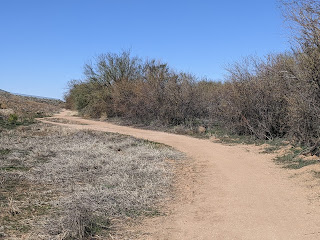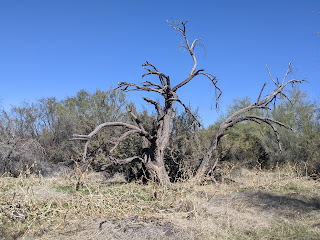
In early February, Steven and I continued to scout out playgrounds in Phoenix in anticipation of our 21-month-old granddaughter, Max, visiting us later in the month from San Francisco. Coyote Basin Park had a fun playground but the trail around the park was supremely boring unless you wanted one that was basically flat as a pancake. What made up for that was watching two men flying a drone in the almost empty park.



A few days later, we checked out Reach 11 Wildlife Area Barrier-Free Nature Trail as a possible place to take Max while her parents worked. The trail was built to provide park patrons the opportunity to experience the desert and enjoy public open spaces. Part of a wildlife area, the trail was set aside for wildlife to use and to seek refuge from encroaching development.
We'd never seen the innards of a saguaro cactus before!
We knew from our visits to other Phoenix parks this month that the Palo Verde is Arizona's state tree. Spanish for 'green stick,' the deciduous tree has small thorns and narrow leaves that don't block out the sun. We couldn't detect what was supposed to be a 'noticeable' blue tint on the Blue Palo Verde, a variation on the green one. The naturally multi-trunk tree can grow 25 feet wide and tall and is drought-tolerant and native to southern Arizona.
One of the most successful plants in the Sonoran Desert ecosystem was the Creosote bush, a medium to large evergreen shrub with many flexible woody stems growing from its base. Well-known for its pungent odor especially after a rainstorm, the creosote also does well in other hot desert areas of North America. Some specimens in the desert have been found to be an astonishing 11,700 years old! Creosote plants can give off a substance from their roots that can kill or inhibit growth on nearby plants that might compete with them for water.
As the rest of the trail had been so desert-like, we were surprised and gladdened to come across a small pond with ducks.
It may not have been the most fascinating of trails but the dead tree shapes made it more appealing.
The almost psychedelic shades of green under a canopy of trees were in such sharp contrast to the shades of dirt everywhere else in the park.
A bush that surely wouldn't win any beauty contests but found in so many Phoenix parks was the Brittlebush with its triangular, silver-green leaves that flower from February through June. When its brittle stems are broken, a yellowish resin is exuded which indigenous people used as an external pain reliever. Spanish missionaries burned the resin as incense in their churches in the early days of the Southwest.

2/11: After driving a fair distance each day for most of our hikes, I'm sure Steven was quite relieved to drive to Lookout Mountain as it was only a few minutes from our rental townhome.

The hike started out easily enough on a fairly level path but we knew that any name with the word 'mountain' in it would definitely be getting harder soon!
After some of the flatter trails Steven and I had been on other mornings, it was more interesting and obviously far more challenging hiking around and around the mountain.
We could easily see the trail ahead of us that we'd be taking.
The trail eventually took us to the top of Lookout Mountain where once again we had marvelous views of Phoenix.
Barrel cacti:
Even though parts of the trail were steeper than I would normally feel comfortable with, once it was completed I found it the most rewarding one yet.
2/12: Cashman Park in a residential neighborhood had a fun playground we thought would be fun for our granddaughter and a path she and her parents might also enjoy when they visited us.
A sign said that Coconino County was created in 1891 and was not only the largest in the state but the second largest in all of the US. The county was home to the Grand Canyon and other famous sites.
In the early 1880s, a desperado stole the workers' payroll during the construction of the Santa Fe Railroad line at Canyon Diablo. Even though the workers formed a posse and caught the thief, the payroll bag was lost in the chase. The moldy money was found several years later by a passing cowboy in the sagebrush! It was fun reading the pieces of Arizona trivia along the path as we certainly had known nothing of the state's nefarious history!
On 2/17 Steven and I hiked in the Deem Hills Preserve in north Phoenix. The name of these mountains comes from early 20th century settlers to the area. After Dennis and Carl Deem settled in the area in 1922, they began homesteading 160 acres of desert land southwest of the hills.
I read that the preserve is mostly composed of Precambrian-era granite and Tertiary Period basalt. The black basalt boulders were remnants of historic lava flows from volcanic activity from currently dormant volcanoes near Flagstaff in northern Arizona.

Though the trail we chose was supposed to be 'easy.' I had some difficulty with the very uneven terrain at the beginning.

Rocks found in the preserve were valued by indigenous Hohokam people for hundreds of years. The basalt was especially useful for tools to grind grains into flours. The chalcedony was a highly coveted white rock likely used for trading purposes.
With every park we visit in Phoenix, we learned more and more about desert habitats. For instance, we hadn't known that a towering saguaro's arms don't begin to develop until it's about 60-80 years of age. When hydrated, they can weigh about 80 pounds per foot. Saguaros can live 200 years and may produce two million seeds, but just two of them may grow to seed-producing adults.
We couldn't tell whether this was a Palo Verde or a Blue Palo Verde tree!
The Ridgeline Trail took us to the highest point on the mountain at an elevation of 2,050 feet where we had commanding views of Phoenix.
From there it was all downhill from there!
We looked back to see the long distance we'd traveled on the preserve's ridgeline and circumference trails. We really liked how diverse the trail was with flat sections to gradual or steep rocky sections. As the name would suggest, it had taken us around the entire Deem Hills Mountain on a great hiking experience.
On February 19th, we drove to the Phoenix suburb of Glendale to hike at the Thunderbird Conservation Park before picking up our son, daughter-in-law, and Max at the airport. Of the several trails at the park, we chose the Cholla Trail, certainly not nearly as challenging as at Deems Hills Preserve but we were sure OK with that!
Rarely had we hiked on a trail that led across a highway - that was the loop part of the trail!
We had a view of the huge Church of Jesus Christ of Latter-Day Saints in Glendale at the end of the trail.

Even though I can see how it might seem from reading this post that Steven and I are into hiking in a major way, our time in Phoenix was an anomaly, I assure you. We do both exercise at home between trips but rarely together and certainly do none of the demanding hikes we did on vacation in Phoenix. That being said, our routine of hiking or walking each morning as the conditions merited was a great way to start the day before lounging by the pool each and every afternoon.
Next post: Visiting Arizona's Capitol Museum for the1st time since January 6th, 2021, when we were present for Arizona's massive rally that coincided with the insurrection taking place in Washington, DC.
Posted on March 15th, 2022, from home in Denver where we are for another week before we once again head away for much warmer climes. When Steven and I began traveling internationally together in 2013, neither of us would have thought, that nine years later, we would possibly be spending more time away from home than at home. The idea still sounds so fantastical, I can hardly believe it myself. I think this is an aberration, though, as I don't think we can keep up this pace for a lot longer even if people do see us as Energizer Bunnies!



























































No comments:
Post a Comment